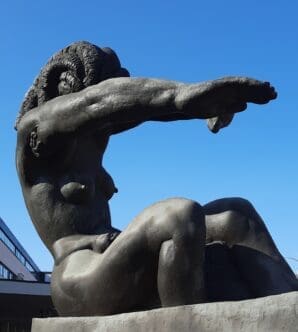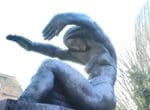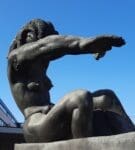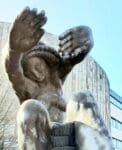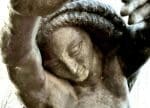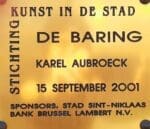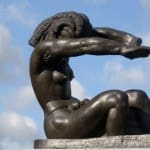DE BARING (KAREL AUBROECK)
Karel Aubroeck was one of the most famous 20th century Flemish sculptors. His art is characterised by monumentalism. His style is expressionistic, showing an affinity with German expressionism. Some sculptures bear witness of a radical simplification by their geometrical and abstract design. Other statues, through their closed character, radiate a turbulent force.
‘De Baring – Giving Birth’ is a tribute to fertility and to the promising future of humanity on the occasion of every new birth. The work’s function is not restricted to rendering a message. The artist imposes high demands on himself and aspires perfect design. The expressive posture and all details in the shape are proof that this sculpture is clearly designed for an open space.
Beside sculptures, the artist also designed houses. In 1924 Karel Aubroeck’s manor ‘De Uil (The Owl)’ in the Fonteinstraat in Temse is built to his own design, in the art-deco style. From 1924 to 1938 the dwelling, with a gallery and studios, was systematically enlarged in function of large orders such as four monumental statues for the IJzermonument in Diksmuide (inaugurated on August 24th 1930) and the King Albert monument in Nieuwpoort (1938). Aubroeck claims to have executed a large part of these extensions himself, such as masonry and concrete casting. He also sculpted the figures on the original wooden front door: the owl, the fountain and Saint Amelberga. The current owners-business managers, designers Roger Liekens and Mark Massa (2002), renovated the house, respecting its past, and had the garden redesigned by the floral artist Daniël Ost from Sint- Niklaas.
AUBROECK Karel (1884-1986)
Karel Aubroeck studied at the Academy of Temse. Later he trained as a woodcarver in Mechelen. In 1914 he was awarded a gold medal for sketching after a live model. After 1918 he studied at the Academy of Mechelen. In 1922 he became a member of the Wase Kunstkring, where he had his first exhibition. From 1922 till 1968 he took part in exhibitions of the Wase Kunstkring and in four Biennals in the Middelheim Museum. He also was President of the Royal Flemish Academy for Arts and Sciences.
- 30-De Baring-20210301-DBR-1
- 30-De Baring-20210301-DBR-2
- 30-De Baring-20210301-DBR-3
- 30-De Baring-20210301-DBR-4
- 30-De Baring-20210301-DBR-5
- 30-De Baring-20210301-DBR-6
- 30-De Baring-20210301-DBR-7
- 30-De Baring-20210301-DBR-8
- 30-De Baring-20210301-DBR-9
- 30-De Baring-20210301-DBR-10
- 30-De Baring-20210301-DBR-11
- 30-De Baring-20210301-DBR-12
- 30-De Baring-20210301-DBR-13
- 30-De Baring-20210301-DBR-14
- 30-De Baring-np-1
- 30-De Baring-20140401
Kunst in de Stad - September 15th 2001

